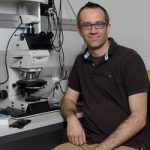
Whether between industry and academic research or materials science and biology, Eric Dufresne, recently appointed Full Professor of Soft and Living Materials at ETH Zurich, finds work most interesting at the interfaces. Take the first example. After starting a company based on a technology developed during his PhD at the University of Chicago, Dufresne went on to work for a well-known management consultancy. His work was business focused, and “very far removed from technology.” It did not feel right.
“The reason I originally wanted to start a company was because I felt that all my research was so abstract that it had no connection to anything real,” Dufresne said. “Then I went to the real world of finance and consulting and I did not like the pure money side of things. During my post-doc I came to appreciate industry as a source of really good scientific problems.”
Dufresne was appointed to the faculty of Yale in 2004 and continued to pursue academic research in parallel with industry collaborations, including partners in the fields of chemicals and personal care, investigating topics as diverse as the physical properties of skin and the stability of electronic inks.
“There has always been at least one person in my lab at any given time working with industry and I’ve always found that it has been a very rewarding relationship,” he said. “Some of the most interesting advances that we’ve made in the lab have been inspired by these partnerships—I’m keen to develop such relationships here in Switzerland.”
In terms of science, while Dufresne’s research focuses on both pure engineering of soft materials—including polymers, foams, gels and colloids—and pure biology, most of the lab’s work is at the interface between the two.The soft materials currently used by engineers are all in thermodynamic equilibrium or kinetically arrested. The systems in living devices though are not even close to equilibrium— the materials themselves usually have embedded energy sources and control systems enabling them to respond to their environments and change their properties. While there is a wide body of research being done on so-called active materials that have embedded energy sources, Dufresne believes that the other element is critical to successfully integrating these materials into devices.
“The embedded control systems are what we really need—that’s what biology has that engineered materials in the lab don’t have,” he said. “‘Soft and living materials’ doesn’t necessarily mean materials used in biology then, it means materials with embedded sources of energy and control systems. I’m really inspired to make better soft materials and that means moving towards these kinds of living materials.
One example of the work he will continue to pursue has to do with the optical properties of materials. Within soft matter physics, one of the longest running challenges has been figuring out how to grow materials that have nanoscale structures that interact strongly with light. The field has only had a limited number of tools and mitigated successes, mostly with a narrow range of crystal structures and optical properties.
The animal kingdom however exhibits much more diversity in the choice of materials and in actual structures and properties. While soft materials produced on the engineering side have been limited to a few simple lattices, nature offers a much wider range of structures and symmetries. Dufresne’s work has included systematically characterising all the structures that produce colour in the natural world and then trying to understand how they work. Now, the lab is looking at how to make such soft materials. Industrial applications could include more efficient optical devices, including solar cells. Another example of the lab’s work involves research into mechanics of soft materials, from human cells and tissues to pressure sensitive adhesives.
Dufresne, who will start full time at ETH in July 2016, says his decision to come to Zurich was largely based on the opportunity to pursue this vision of soft and living materials.
“The resources at ETH are amazing, and this completely changes the way I frame my research,” he said. “Being able to articulate this vague but powerful idea about living materials and moving my lab towards that over next 25 years is something that I could only pursue here.”
Text by Carey Sargent (March 2016)